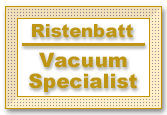The beauty, warmth and softness of carpeted floors have made them very attractive to many people. With carpet comes the challenge of removing the grit, dirt and dust that somehow find their way deep into the carpet nap. Over the years vacuum cleaners have advanced to the point that they are very capable of removing these items and preventing them from being recirculated back into the living environment. For details on how to efficiently trap the fine dust and allergens, see our article on Filtration Efficiency - HEPA, Micron, etc.
Effectiveness of the Standard Canister
A standard canister type of vacuum cleaner relies primarily on its air flow to pick up dirt and carry it into the dirt container. This works quite well for cleaning non-carpeted floors with a floor brush as well as dusting wooden furniture, cleaning upholstered furniture and catching those small corners with the smaller attachments. The bristles on a floor brush help to gather the dirt and grit while keeping the air flow very close to the floor surface.
Moving air alone is far from adequate when it comes to removing deeply embedded dirt in carpets since it is nearly impossible to have the air flow reach the deep dirt with sufficient velocity to motivate it to move from its place. Most standard carpet nozzles have a stationary brush strip which aids in the removal of dirt, lint, hair, threads, etc. which are near the surface of the carpet but this still falls far short of reaching the dirt near the base of the carpet nap. Grit, with its sharp edges and corners, is one of the primary causes of carpet wear. The revolving brush roll was developed to make a huge difference in the effectiveness of a vacuum cleaner in removing this deeply embedded dirt. Its high speed brushing action and agitation also fluff the carpet nap, giving it a fresher, newer look.
A Revolving Brush Roll Greatly Enhances Carpet Cleaning
Vacuum cleaners specifically designed to clean carpeted floors have motor or turbine driven revolving brush rolls with rows of bristles and sometimes beater bars as well. These brush rolls revolve at a very high speed, agitating the carpet fibers in the process. The effect of this is to loosen dirt and move it toward the top, aiding in its removal from the carpet fibers. The suction from the motor pulls the carpet under the nozzle up against it, bowing it backward slightly. This helps to separate the nap, enhancing the air flow through it and allowing the bristles to sweep the dirt and grit upward. When beater bars or stiffened bristles are included on the brush roll, they tap the carpet back quickly. Due to inertia, the grit and dirt want to stay stationary as the carpet moves downward. The combination of the high speed brushing and beating actions is very effective in moving the dirt and grit upward in the carpet fibers so the air flow can carry them away.
The aggressiveness of a revolving brush roll goes a long way toward its ability to deep clean carpets but this can be harmful to some carpets like Berber and delicate oriental carpets if the bristles are too harsh. A number of manufacturers of Berber carpets do not recommend using a revolving brush roll on them since the tops of the loops can be damaged. A type of cut Berber instead of looped Berber has recently become available which has the durability of Berber but with less risk of damage from a revolving brush roll. We recommend that you check with the manufacturer or their representative to determine whether to use a revolving brush on Berber or delicate oriental carpets. If you choose to use a revolving brush roll on delicate carpets, we recommend the Miele SEB 217-3 Powerbrush which are available with some Miele Power Teams since its long soft bristles are fairly gentle on the carpet fibers.
The Hoover Company calls their brush roll an "agitator." They are the inventor of the beater bar which they used for many years. They even promoted it with the phrase "It Beats as it Sweeps as it Cleans." After their patent expired, many other companies added beater bars to their brush rolls. Today most manufacturers have moved away from the use of a beater bar in favor of two rows of bristles instead of one row of bristles and a beater bar.
Revolving Brush Roll Variations
Most manufacturers use plastic, acrylic or wooden brush rolls with the bristles embedded into the roll itself. Some of the higher quality vacuum cleaners use steel brush rolls with replaceable brush strips and ball bearings. Brush rolls come in many shapes and sizes, some are round, others are contoured or auger shaped. Some have few bristles and no beater bars, others have many bristles and beater bars. Even the speed at which they rotate varies from model to model, some as high as 6,500 RPM. Don't let the speed of the brush roll mislead you though. Some of the fastest revolving brush rolls have very few bristles on them.
Revolving brush rolls are found in all Traditional Uprights, all "Clean-Air" Uprights, all Two-Motor Uprights, all Two-Motor Power Teams as well as some Hand Held Vacuum Cleaners. The motorized carpet nozzles on the two-motor power teams and central vacuum systems are typically called power nozzles. Some Standard Canisters and Central Vacuum Systems have turbine nozzles which have revolving brush rolls driven by turbines instead of motors.
Motorized Power Nozzles vs. Air Driven Turbine Nozzles
To distinguish between the two types of carpet cleaning nozzles with revolving brush rolls, they are often referred to as a motor driven power nozzle and an air driven turbine nozzle. When using a power nozzle, the electric motor actually adds power to the cleaning system. A turbine nozzle should not be confused with a motorized power nozzle. When a turbine is used instead of an electric motor, the power to drive the brush roll is actually removed from the air flow, reducing the velocity of the air flow through the system. Both types of nozzles incorporate a revolving brush roll similar to that used in the upright type of vacuum cleaner to deep clean the carpets. The better ones use a non-slip Cog or Reinforced Banded V-belt type of belt for better power transfer from the motor or turbine to the brush roll.
Upholstery Tools with Revolving Brush Rolls
Some power teams and central vacuum systems have motorized upholstery tools which are like miniature power nozzles with their own electric motors and revolving brush rolls. These are ideal for deep cleaning upholstery, carpeted stairs, beds, etc. Since the suction is created by a large canister or central system motor a motorized upholstery tool is more effective than using a small hand held vacuum cleaner. Having its own motor to drive the revolving brush, it adds to the power of the cleaner like the full size power nozzle. Available for use on most vacuum cleaners are upholstery nozzles with turbine driven revolving brush rolls like the Miele STB 101 Turbobrush and generic 0905C and 120 Air Turbine Upholstery Nozzles. Whether motor driven or turbine driven, these powered brushes can make a significant difference in the effectiveness of their upholstery nozzles.
Summary
By using a motor driven revolving brush roll, carpet cleaning is much, much more effective than when using a standard carpet nozzle having only a stationary brush strip. Ease of use is greatly improved as well since the cleaning nozzle can glide easily across the carpet. The revolving brush roll even helps to pull the nozzle forward, giving the feel of being self-propelled on some cleaners. Powered revolving brush rolls are found in uprights, power teams, central vacuum systems and hand vacs which come in many different sizes, shapes and prices to fit almost any cleaning task, preference and budget.
Next Vacuum Performance Aspect: Loss of Vacuum Cleaner Performance













